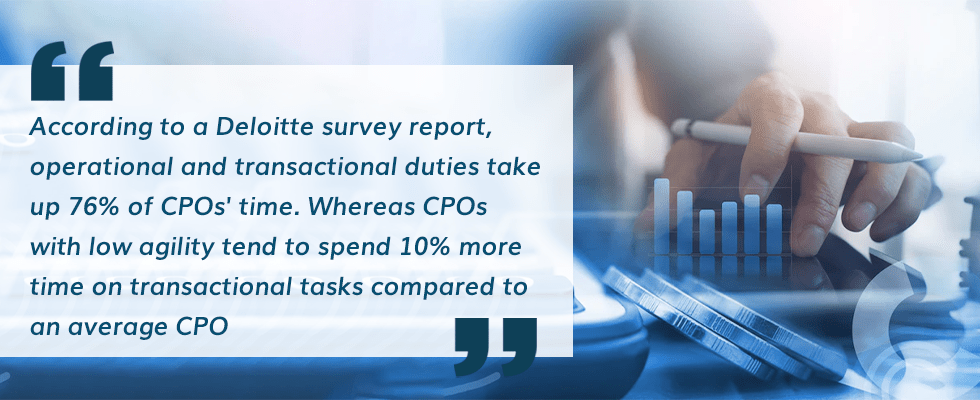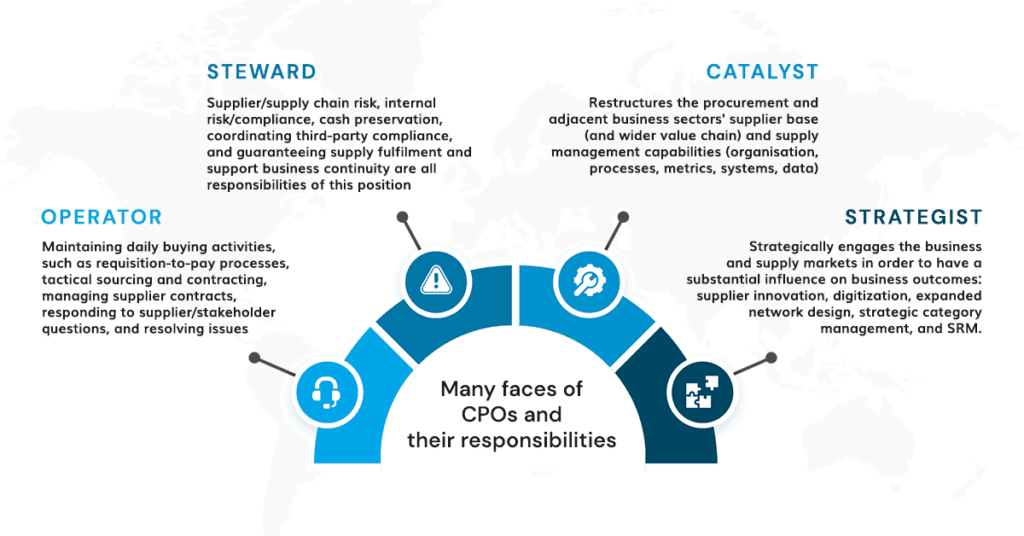Table of Contents
ToggleWhat steps does Chief Procurement Officer’s take to ensure success?
Market developments in recent years, such as the pandemic’s lingering consequences, have undoubtedly sparked significant changes in procurement organizations. There is no doubt that procurement has become complicated, but as the saying goes, ‘With every difficulty there is an opportunity!’. With the increasing complexities and disruptions in supply chains, procurement has evolved as a vital function within any organization. Organizations have realized that keeping supply chain networks lean is as crucial as keeping them secure. Hence, moving forward, what can we anticipate from the post-pandemic world and what steps should CPOs (Chief Procurement Officers) take on their way ahead to ensure success? The procurement executives have spent the last two years redesigning their supply chains. Leaders had to employ resilient supplier sourcing strategies to adjust to the ‘new normal’. However, the transformation that chief procurement officer (CPOs) had to face, along with the added complexities, had been piling up even long before the pandemic.
Now, it’s no longer just about focusing on cost-cutting and improving operational efficiency. Procurement innovation entails moving beyond cost reductions, adopting new dynamic and projective Strategic Sourcing and Procurement techniques, partnering with stakeholders across all business departments, thoroughly understanding the organization’s requirements and promoting sustainable and agile methods to achieve success.
The significance of CPOs (Chief Procurement Officer) in Agile Enterprises
CPOs are more crucial than people may realize. They manage an organization’s procurement department and control the purchases of products and services, thus impacting many other functions.
- A CPO’s responsibility is to guarantee that purchases are made to suit organizational needs while also minimizing costs or gaining profit margins or both.
- A procurement plan based on strategic sourcing is developed by the CPO.
- CPO assists the buying department in evaluating and selecting suppliers.
- CPO monitors and occasionally participates in Contract Management Workflows.
- CPOs must also endeavor to ensure that procurement policies and procedures correspond to internal and external compliance criteria.
- Transactions involving strategic alliances with suppliers and/or significant expenses may be handled directly by the CPO.
- CPO ensures maintaining diversity in terms of the number of suppliers.
- It is their responsibility to listen and understand procurement team’s requirements
- They need to align sourcing with the business objectives and strategies such as new geographies, new products or services etc.,
How CPOs can re-orient their operations to be more agile and strategic?

According to a Deloitte survey report, operational and transactional duties take up 76% of CPOs’ time. Whereas CPOs with low agility tend to spend 10% more time on transactional tasks compared to an average CPO. This suggests that there is a need for the procurement leaders (CPOs) to adopt global strategic sourcing techniques that are more flexible, can tolerate unpredictability in supply and demands as well as can swiftly redesign the value chain processes to suit market requirements. So, how is it possible to accomplish all of this? The answer is ‘Agility’.

eBook – CPO Guide 2024
Agility can play a significant role in enabling high performance while also acting as a countermeasure to managing risks, complexities, and disruptions. The goal of becoming agile is to alter the procurement department by establishing a set of skills for tracking important KPIs, stakeholders, and supplier marketplaces. So, what exactly can an Agile CPO do?
- Agile CPOs can adapt themselves on the fly with fresh ideas and new digital tools.
- They can use their relevant stakeholder connections and greater supplier data to target top-line possibilities.
- An agile CPO can outperform on all the KPIs including target savings, expense, stakeholder influence, C-level (Chief-level) impact, and attain stakeholder satisfaction.
- They are good at-risk minimization and have a great drive to achieve their goals.
Here are some recommendations for today’s CPOs (Chief Procurement Officer) to consider to bring agility to their organizations:
1. Align procurement’s value offering with the goals of the C-suite
CPOs must examine their performance indicators and value propositions to verify that they align with the organization’s goals of cost reduction, risk minimization, sustainability, and revenue growth.
2. Approach strategic category management with greater agility and collaboration.
Stakeholder engagement and comprehensive access to accurate category information, such as expenditure statistics and market intelligence, are essential components of a successful category management program. To meet such objectives, CPOs must expedite strategic Category Management.
3. Enhance supplier risk management and governance practices.

According to the Deloitte CPO Survey, only 18% of CPOs (Chief Procurement Officer) can track the risks in their immediate supplier network while only 15% have insight beyond that. Thus, CPOs must understand and implement risk management, resiliency, and agility metrics throughout their enterprises. They must concentrate on laying the groundwork for the identification of risks, assessment, and mitigation techniques in a segmented supplier base to manage risks effectively.
4. Collaborate with suppliers and new third-party parties to foster innovation.

54% of CPOs aim to strengthen engagement with suppliers, according to the Procurement Leaders study. CPOs must consider their managed service providers and partners as an extension of their organization, and stakeholder management must be at the forefront of their agile strategy. The goal of third-party centricity is to build effective relationships with Suppliers to improve performance while driving transformation and risk management.
5. Adopting a digital transformation strategy
In a Gartner 2021 survey report, technology was the second most priority for all supply chain respondents, showing an increase of 26% from the previous year. CPOs can enhance digitization in procurement in the areas of data visibility, agility, and collaboration with suppliers by concentrating on next-gen technologies such as IoT, blockchain, AI/Machine learning, automation, and advanced Procurement Analytics Software.
6. Improve the procurement team’s abilities and talent.
CPOs should concentrate on closing the skill gaps that hinder agility. All procurement team members should improve their soft skills, such as strategic thinking and business acumen to fine-tune supplier management automation and sourcing strategy, as well as their hard skills such as negotiation skills, decision-making, data analytics and technical expertise, regularly.
Conclusion
CPO’s (Chief Procurement Officer) have progressed drastically from being operators responsible for closing deals, managing contracts and expenses to being transformative catalysts and brilliant strategists. However, given the erratic conflicting priorities faced by the organizations today, the CPO should design a clear vision and plan that matches the business requirements.
Becoming an agile CPO requires adopting a more strategic approach, through an in-depth understanding of the tasks, embracing Digital Transformation in Procurement, sustainability, targeted capabilities development, and cross-stakeholder collaboration. Certainly, being an agile CPO will require a significant amount of effort, and there will be no rest anytime soon!!



